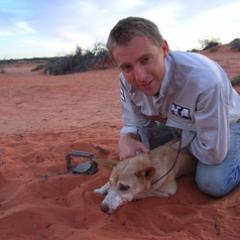Background
Australia is in the midst of a biodiversity crisis (Woinarski et al. 2015), of which exotic species, particularly the red fox (Vulpes vulpes), are considered to be a large driver (Short & Smith 1994). To help mitigate the impacts of foxes, control is necessary (Saunders et al. 2010). Para-aminopropiophenone (PAPP) is a toxin recently scheduled for use in Australian pest control programs for use in canid pest ejectors. The poison has the potential to overtake 1080 as the poison of choice for fox control. Benefits over 1080 include relative humaneness and an accessible antidote, while lacking the controversy associated with 1080 (Saunders & McLeod 2007).
An issue with PAPP is that its target specificity has not been researched in the field to the same extent as 1080, potentially posing a risk to a number of species (Mallick et al. 2016). It is believed that this risk can be reduced by using a meat lure and M-44 canid pest ejectors (Marks & Wilson 2005). The M-44 ejector mechanism requires 1.6-2.7 kg of upwards pull force to eject the poison. This required force has been predicted to functionally inhibit all mammal species from the poison besides foxes, dogs/dingoes, quolls and Tasmanian devils (Marks & Wilson 2005); mountain/common brushtail possums are potentially capable of triggering ejectors at their highest weight range (Marks & Wilson 2005). The efficacy of using 400 mg of PAPP (fox dose rate) in M-44 ejectors in reducing fox numbers has not been reported, and its non-target impacts not quantified in the field. This is important information that needs to be known prior to large scale use. The impacts, particularly in regards to dingoes/wild dogs, will likely impact how, and where, the method will be utilised.
Aims
- Determine the efficacy of fox dose rate PAPP armed canid pest ejectors for a fox management program
- Understand the impacts on abundance and behaviour of dingoes/wild dogs and other non-target species
Methodology
A fox control program was monitored for changes in fox, wild dog and other non-target species’ abundance and behaviour before and after treatment and compared to a non-treatment site of similar habitat types.
Two methods were used to determine abundance indices: 27 white flash cameras and 25 sand plots. The cameras were deployed and active from one-month pre-treatment, until two weeks post-treatment, providing fortnightly indices throughout the study. These cameras also provided data on individual dingoes/wild dogs and provided insight into their ecology. Sand plots were completed for a five-night period, pre and post treatment.

Expected outcomes
It is expected that fox numbers will drop as a result of the treatment, which will be recognised via the two abundance indices. It is expected that only foxes, dingoes/wild dogs, goannas, and potentially possums will be capable of triggering ejectors. Infrared camera data will show how these species trigger the ejector to help determine whether they are at risk of a fatal dose or not.
The results of this research will inform development of an integrated adaptive fox management program at a local scale but will also potentially be used in land management decision across Australia, where efficacy of pest control and the consequences for non-target species are important factors.
References
Mallick, S, Pauza, M, Eason, C, Mooney, N, Gaffney, R & Harris, S 2016, 'Assessment of non-target risks from sodium fluoroacetate (1080), para-aminopropiophenone (PAPP) and sodium cyanide (NaCN) for fox-incursion response in Tasmania', Wildlife Research, vol. 43, no. 2, pp. 140-52.
Marks, CA & Wilson, R 2005, 'Predicting mammalian target-specificity of the M-44 ejector in south-eastern Australia', Wildlife Research, vol. 32, no. 2, pp. 151-6.
Saunders, G & McLeod, L 2007, Improving fox management strategies in Australia, Bureau of Rural Sciences Canberra.
Saunders, GR, Gentle, MN & Dickman, CR 2010, 'The impacts and management of foxes Vulpes vulpes in Australia', Mammal Review, vol. 40, no. 3, pp. 181-211.
Short, J & Smith, A 1994, 'Mammal decline and recovery in Australia', Journal of Mammalogy, vol. 75, no. 2, pp. 288-97.
Woinarski, JC, Burbidge, AA & Harrison, PL 2015, 'Ongoing unraveling of a continental fauna: decline and extinction of Australian mammals since European settlement', Proceedings of the National Academy of Sciences, vol. 112, no. 15, pp. 4531-40.
Acknowledgements
Hidden Vale Wildlife Project Research Support Funding




